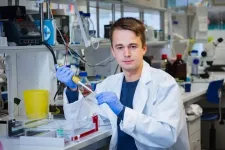TalTech's neuroscientists investigate the causes of a widespread eye disease
2021-01-13
(Press-News.org) Fuchs' corneal dystrophy is one of the most common eye diseases diagnosed in almost 5% of the population of Europe aged 40 years or over. It is a hereditary eye disease that causes vision impairment and typically manifests in middle age. The first symptoms of the disease - blisters on the surface of your cornea - resemble cataract at first glance. The disease progresses from the centre of the cornea affecting all layers of the cornea. The progression of the disease varies from individual to individual and in severe cases results in vision loss.
The molecular neurobiology research group led by Professor of Molecular Biology Tõnis Timmusk published an article about Fuchs' dystrophy in the journal Scientific Reports titled "The Fuchs corneal dystrophy-associated CTG repeat expansion in the TCF4 gene affects transcription from its alternative promoters", authored by Alex Sirp, Kristian Leite, Jürgen Tuvikene, Kaja Nurm, Mari Sepp and Tõnis Timmusk.
Professor Timmusk says, "Currently, the only method used to treat Fuchs' corneal dystrophy is a surgical procedure, in the course of which the patient's whole cornea is replaced. However, such a treatment is complicated because it requires availability of donor tissue. To prevent an unpleasant surgical procedure, we are working to better understand the causes of Fuchs' dystrophy and to find ways to prevent it."
The human genome - DNA - is composed of chains of four different types of nucleotides (abbreviated A, T, C and G). Their different combinations make us actually who we are. Repeated sequences occur in DNA, i.e. some combinations in our genome can be repeated tens or hundreds or even thousands of times. Such repeats are unstable, varying in length between individuals as well as in different tissues of the same individual.
"Expansion of certain repeats can cause repeat expansion diseases. In most cases, such diseases are caused by abnormal repeat expansion of three nucleotides, which is why they are known also as trinucleotide repeat disorders," says one of the lead authors of the article, PhD student Alex Sirp.
Trinucleotide repeat disorders are a set of over 40 different disorders, including Huntington's disease, fragile X syndrome, myotonic dystrophy, etc. The Fuchs' endothelial corneal dystrophy is caused by the CTG trinucleotide repeat expansion in Transcription factor 4 (TCF4). While the repeat length in healthy persons remains below 40, the repeat length in persons with visual impairment is above 40 repeats. "TCF4 gene pays an important role in the development and functioning of the human nervous system. Mutations and variations in TCF4 are directly associated with schizophrenia, mental retardation and a very rare disorder called Pitt-Hopkins Syndrome, " says Sirp.
Tõnis Timmusk says, "The results of our study showed that CTG repeat expansion affects the expression of TCF4 in cultured cells. Due to rapid advances in genomic technologies in recent years, we were able to compare expression of the TCF4 gene in the corneal endothelium of healthy persons and patients with Fuchs' dystrophy. The results revealed changes in TCF4 expression levels in case of Fuchs' endothelial corneal dystrophy.
The findings of the research help to understand how these (tri)nucleotide repeats can affect development of a disease through changes in gene expression. These results may also contribute to the development of drugs for the treatment of Fuchs' dystrophy.
"As a next step, we want to determine when and for how long changes in TCF4 level occur in people who later develop Fuchs' endothelial corneal dystrophy. This would make it possible to develop a treatment strategy that would enable regulation of TCF4 levels in the corneal endothelium and thus prevent the disease," says Professor Timmusk.
INFORMATION:
Source:
Scientific Reports article titled "The Fuchs corneal dystrophy-associated CTG repeat expansion in the TCF4 gene affects transcription from its alternative promoters" 28.10.2020
https://www.nature.com/articles/s41598-020-75437-3
Additional information:
Professor at TalTech Department of Chemistry and Biotechnology, Division of Gene Technology Tõnis Timmusk,
tonis.timmusk@taltech.ee
and
Early Stage Researcher Alex Sirp,
alex.sirp@taltech.ee
Kersti Vähi, TalTech Research Administration Office
[Attachments] See images for this press release:

ELSE PRESS RELEASES FROM THIS DATE:
2021-01-13
With ever-worsening climate change, there is a growing need for technologies that can capture and use up the atmospheric CO2 (carbon dioxide) and reduce our carbon footprint. Within the realm of renewable energy, CO2-based e-fuels have emerged as a promising technology that attempts to convert atmospheric CO2 into clean fuels. The process involves production of synthetic gas or syngas (a mixture of hydrogen and carbon monoxide (CO)). With the help of the reverse water-gas shift (RWGS) reaction, CO2 is broken down into the CO necessary for syngas. While promising in its conversion efficiency, the RWGS reaction requires incredibly high temperatures (>700°C) to proceed, while also generating ...
2021-01-13
In a new study, researchers at Karolinska Institutet in Sweden have used a urine test to identify and verify a patient's type of asthma. The study, which has been published in the American Journal of Respiratory and Critical Care Medicine, lays the foundation for a more personalized diagnosis and may result in improved treatment of severe asthma in the future.
About 10 percent of the Swedish population suffers from asthma, a disease that has become increasingly widespread over the past 50 years, with annual global mortality of around 400,000 according to the World Health Organization. Asthma is characterized by chronic inflammation in the airways, which can result in symptoms including ...
2021-01-13
In three recent publications in Molecular Psychiatry, Brain and JAMA Neurology researchers from the University of Gothenburg provide convincing evidence that an in-house developed blood test for Alzheimer's disease can detect the disease early and track its course, which has major implications for a potential use in clinical practice and treatment trials.
"This is an extremely dynamic research field right now, thanks to the technological development and seminal scientific progress in the past years. The dream scenario is to have a blood test for the early detection and screening of Alzheimer's disease up and running. That would give significantly ...
2021-01-13
Workaholism or work addiction risk is a growing public health concern that can lead to many negative mental and physical health outcomes such as depression, anxiety or sleep disorder. Perception of work (job demands and job control) may become a major cause of employees' work addiction. The international group of researchers including the HSE University scientist explored the link between work addiction risk and health-related outcomes using the framework of Job Demand Control Model. The results were published in the International Journal of Environmental Research and Public Health.
Workaholics are people who usually work seven and more hours more than ...
2021-01-13
Optical sensors can quantitatively analyze chemical and biological samples by measuring and processing the optical signals produced by the samples. Optical sensors based on infrared absorption spectroscopy can achieve high sensitivity and selectivity in real time, and therefore play a crucial role in a variety of application areas such as environmental sensing, medical diagnostics, industrial process control and homeland security.
In a new paper published in Light: Science & Applications, a team of scientists, led by Dr. Peter Q. Liu from the Department of Electrical Engineering, the State University of New York at Buffalo, have demonstrated a new type of high-performance optical sensor which can utilize ...
2021-01-13
Metal surfaces play a role as catalysts for many important applications - from fuel cells to the purification of car exhaust gases. However, their behaviour is decisively affected by oxygen atoms incorporated into the surface.
This phenomenon has been known for a long time, but until now it has not been possible to precisely investigate the role of oxygen in complex surfaces point by point in order to understand the chemical background at the atomic level. This has now been achieved at TU Wien in cooperation with a team from the Elettra Synchrotron in Trieste. It became possible ...
2021-01-13
A remarkable prediction of Einstein's theory of general relativity--the theory that connects space, time, and gravity--is that rotating black holes have enormous amounts of energy available to be tapped.
For the last 50 years, scientists have tried to come up with methods to unleash this power. Nobel physicist Roger Penrose theorized that a particle disintegration could draw energy from a black hole; Stephen Hawking proposed that black holes could release energy through quantum mechanical emission; while Roger Blandford and Roman Znajek suggested electromagnetic ...
2021-01-13
Irvine, Calif., Jan. 11, 2021 - Often admired for their flawless appearance to the naked eye, crystals can have defects at the nanometer scale, and these imperfections may affect the thermal and heat transport properties of crystalline materials used in a variety of high-technology devices.
Employing newly developed electron microscopy techniques, researchers at the University of California, Irvine and other institutions have, for the first time, measured the spectra of phonons - quantum mechanical vibrations in a lattice - at individual crystalline faults, and they discovered the propagation of phonons near the flaws. The team's findings are the subject of a study published recently in Nature.
"Point defects, dislocations, stacking ...
2021-01-13
Irvine, Calif., Jan. 5, 2021 -- Scientists at the University of California, Irvine have developed a new deep-learning framework that predicts gene regulation at the single-cell level.
Deep learning, a family of machine-learning methods based on artificial neural networks, has revolutionized applications such as image interpretation, natural language processing and autonomous driving. In a study published recently in Science Advances, UCI researchers describe how the technique can also be successfully used to observe gene regulation at the cellular level. Until now, that process had ...
2021-01-13
A pioneering study by University of Bristol researchers finds that the evolution of teeth in the giant prehistoric shark Megalodon and its relatives was a by-product of becoming huge, rather than an adaptation to new feeding habits.
The iconic extinct Megalodon was the largest shark to ever roam the seas. Its name translates to 'big tooth', making reference to its massive teeth, which represent the most abundant fossil remains of the species. They are broad and triangular, nothing like the curved, blade-like teeth of the closest relatives of Megalodon.
The ...
LAST 30 PRESS RELEASES:
[Press-News.org] TalTech's neuroscientists investigate the causes of a widespread eye disease







